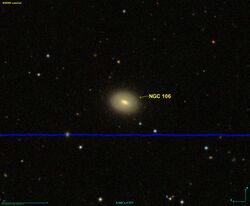Astronomy:NGC 106
From HandWiki
Short description: A Lenticular galaxy in the constellation Pisces
| NGC 106 | |
|---|---|
 SDSS image of NGC 106 | |
| Observation data (J2000 epoch) | |
| Constellation | Pisces |
| Right ascension | 00h 24m 43.753s[1] |
| Declination | −05° 08′ 55.71″[1] |
| Redshift | 0.020211[2] |
| Helio radial velocity | 6059[2] |
| Distance | 199 Mly (61.1 Mpc)[2] |
| Apparent magnitude (B) | 14.46[3] |
| Characteristics | |
| Type | Sa: pec[2] |
| Size | 64,800 ly (19,880 pc)[2][note 1] |
| Apparent size (V) | 1.3′ × 0.6′[2] |
| Other designations | |
| PGC 1551, 2MASX J00244375-0508557[3] | |
NGC 106 is a lenticular galaxy estimated to be about 270 million light-years away in the constellation of Pisces. It was discovered by Francis Leavenworth in 1886 and its apparent magnitude is 14.5.[4]
Notes
- ↑ 2MASS Ks band used.

NGC 106 in infrared
References
- ↑ 1.0 1.1 Skrutskie, Michael F.; Cutri, Roc M.; Stiening, Rae; Weinberg, Martin D.; Schneider, Stephen E.; Carpenter, John M.; Beichman, Charles A.; Capps, Richard W. et al. (1 February 2006). "The Two Micron All Sky Survey (2MASS)". The Astronomical Journal 131 (2): 1163–1183. doi:10.1086/498708. ISSN 0004-6256. Bibcode: 2006AJ....131.1163S. https://ui.adsabs.harvard.edu/abs/2006AJ....131.1163S/abstract.
- ↑ 2.0 2.1 2.2 2.3 2.4 2.5 "NED results for object NGC 0106". National Aeronautics and Space Administration / Infrared Processing and Analysis Center. http://nedwww.ipac.caltech.edu/cgi-bin/nph-objsearch?objname=NGC+106&extend=no&out_csys=Equatorial&out_equinox=J2000.0&obj_sort=RA+or+Longitude&of=pre_text&zv_breaker=30000.0&list_limit=5&img_stamp=YES.
- ↑ 3.0 3.1 "NGC 106". SIMBAD. Centre de données astronomiques de Strasbourg. http://simbad.u-strasbg.fr/simbad/sim-basic?Ident=NGC+106.
- ↑ "NGC Objects: NGC 100 - 149". http://cseligman.com/text/atlas/ngc1.htm#106.
External links
 |

